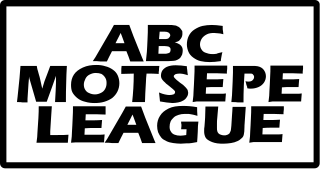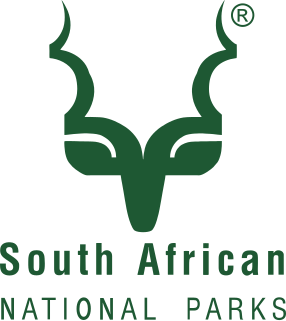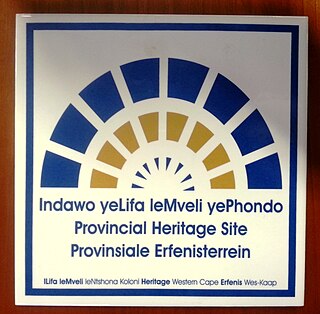Related Research Articles

South Africa occupies the southern tip of Africa, its coastline stretching more than 2,850 kilometres from the desert border with Namibia on the Atlantic (western) coast southwards around the tip of Africa and then northeast to the border with Mozambique on the Indian Ocean. The low-lying coastal zone is narrow for much of that distance, soon giving way to a mountainous escarpment that separates the coast from the high inland plateau. In some places, notably the province of KwaZulu-Natal in the east, a greater distance separates the coast from the escarpment. Although much of the country is classified as semi-arid, it has considerable variation in climate as well as topography. The total land area is 1,220,813 km2 (471,359 sq mi). It has the 23rd largest Exclusive Economic Zone of 1,535,538 km2 (592,875 sq mi).

The Vaal River is the largest tributary of the Orange River in South Africa. The river has its source near Breyten in Mpumalanga province, east of Johannesburg and about 30 kilometres (19 mi) north of Ermelo and only about 240 kilometres (150 mi) from the Indian Ocean. It then flows westwards to its conjunction with the Orange River southwest of Kimberley in the Northern Cape. It is 1,120 kilometres (700 mi) long, and forms the border between Mpumalanga, Gauteng and North West Province on its north bank, and the Free State on its south.

The Highveld is the portion of the South African inland plateau which has an altitude above roughly 1500 m, but below 2100 m, thus excluding the Lesotho mountain regions to the south-east of the Highveld. It is home to some of the country's most important commercial farming areas, as well as its largest concentration of metropolitan centres, especially the Gauteng conurbation, which accommodates one-third of South Africa's population.

Municipal elections were held in South Africa on 1 March 2006, to elect members to the local governing councils in the municipalities of South Africa. The municipalities form the local government of South Africa and are subdivisions of the provinces, thus making them responsible for local service delivery, such as electricity, water and fire services.

The ABC Motsepe League, previously known as the Vodacom League between 1998 and 2012, was founded in 1998 as the current Second Division and the overall third tier of South African football. The competition is regulated by SAFA, and until 2012 had been sponsored by mobile telecommunications company Vodacom.

South African National Parks (SANParks) is the body responsible for managing South Africa's national parks. SANParks was formed in 1926, and currently manages 19 parks consisting of 3,751,113 hectares (37,511.13 km2), over 3% of the total area of South Africa.

The South African Heritage Resources Agency (SAHRA) is the national administrative body responsible for the protection of South Africa's cultural heritage. It was established through the National Heritage Resources Act, number 25 of 1999 and together with provincial heritage resources authorities is one of the bodies that replaced the National Monuments Council.

Provincial heritage sites in South Africa are places that are of historic or cultural importance within the context of the province concerned and which are for this reason declared in terms of Section 28 of the National Heritage Resources Act (NHRA) or legislation of the applicable province. The designation was a new one that came into effect with the introduction of the Act on 1 April 2000 when all former national monuments declared by the former National Monuments Council and its predecessors became provincial heritage sites as provided for in Section 58 of the Act.

Nomvula Paula Mokonyane was the Minister of Environmental Affairs in South Africa, appointed on 22 November 2018 under President Cyril Ramaphosa. She was first appointed to the cabinet of South Africa in May 2014 under President Jacob Zuma, serving as Minister in the Department of Water and Sanitation, and became Minister of Communication under President Cyril Ramaphosa in January 2018. Prior to serving in Cabinet, she was the Premier of Gauteng province, elected following the 2009 South African general election. She is also Honorary President of SA-China People's Friendship Association.
Metisella malgacha, the grassveld sylph, is a butterfly of the family Hesperiidae. It is found in the Cape, Free State, Lesotho, Transvaal, and KwaZulu-Natal in South Africa. The habitat consists of grassland and grassy areas in the fynbos and Karoo.

The distribution of white South Africans is fairly evenly spread. They currently make up 8-9% of the total population and are around 4.5–5 million. They are found in large numbers in practically every province in South Africa but always as a minority. They are high in concentration in large cities.
The Twelfth Amendment of the Constitution of South Africa altered the boundaries of seven of South Africa's nine provinces. It also redefined all of the provinces' geographical areas in terms of the areas of district and metropolitan municipalities, and repealed the provisions introduced by the Third Amendment that allowed municipal areas to cross provincial boundaries. A number of the boundary changes were highly controversial and led to popular protest and court challenges.
The Department of Transport is the department of the South African government concerned with transport. The political head of the department is the Minister of Transport, currently Fikile Mbulula; his deputy is Sindisiwe Chikunga.
There have been a number of political assassinations in post-apartheid South Africa. In 2013 it was reported that there had been more than 450 political assassinations in the province of KwaZulu-Natal since the end of apartheid in 1994. In July 2013 the Daily Maverick reported that there had been "59 political murders in the last five years". In August 2016 it was reported that there had been at least twenty political assassinations in the run up to the local government elections on the 3rd of August that year, most of them in KwaZulu-Natal.
South African Korfball Federation (SAKF) is the governing body for the sport of Korfball in South Africa. The national body has 10 regional member associations in its organisation structure. It is affiliated with the world governing body International Korfball Federation. SAKF organises men's and women's competitions annually amongst its regional members across age groups. The men's national team have won three All-Africa Korfball Championship and participated at the IKF World Korfball Championship.
The 2018 Africa T20 Cup was the fourth and final edition of the Africa T20 Cup, a Twenty20 cricket tournament. It was held in South Africa in September 2018, as a curtain-raiser to the 2018–19 South African domestic season. Provincial side KwaZulu-Natal Inland were the defending champions.
The 2019–20 CSA Provincial T20 Cup was a domestic Twenty cricket tournament that took place in South Africa in September 2019, as a curtain-raiser to the 2019–20 South African domestic season. It was played between the thirteen South African provincial teams, along with Limpopo and Mpumalanga. This was the sixth edition of the CSA Provincial T20 Cup, which was last played in the 2015–16 season. With only domestic teams from South Africa taking part, the tournament returned in place of the Africa T20 Cup, which had been held since 2015.
The 2020–21 CSA 3-Day Provincial Cup was a first-class cricket competition that took place in South Africa during February and March 2021. Easterns and KwaZulu-Natal were the defending champions, after the title was shared due to the COVID-19 pandemic.
The 2020–21 CSA Provincial One-Day Challenge was a domestic one-day cricket tournament that was played in South Africa in February and March 2021. Free State and Northern Cape were the defending champions, after the title was shared due to the COVID-19 pandemic.
References
- ↑ Republic of South Africa, Department of Water Affairs. "Water Service Institutions" . Retrieved 4 September 2012.CS1 maint: discouraged parameter (link)
- ↑ Infrastructure Barometer 2006, p. 123
- ↑ H. T. Montague Bell, C. Arthur Lane, British Association for the Advancement of Science, Meeting, South African Association for the Advancement of Science (1905). "The Rand Water Supply". A Guide to the Transvaal. Bartholomew & Lawlor. p. 88. Retrieved 11 August 2010.CS1 maint: discouraged parameter (link) CS1 maint: multiple names: authors list (link)
- ↑ AfDevInfo:Water Boards
- ↑ Mntambo, 2 Sep 2009. Department of Water Affairs (Mpumalanga) Support and Intervention to Local Government Institutions. Presentation to the Portfolio Committee on Water and Environmental Affairs
- ↑ (Advertorial) (21 May 2015). "Mhlathuze Water in a nutshell". Mail & Guardian.
- ↑ "Sedibeng Water - Sustaining the Source and Flow of Life Forever".
- ↑ National Water Resource Strategy. 2004. Chapter 3, Part 5 – Water Management Institutions
- ↑ National Water Act
- ↑ Department of Water Affairs (1 April 2014). "Disestablishment of Botshelo Water" (PDF). Government Gazette. Retrieved July 8, 2019.
- ↑ Department of Water Affairs (1 April 2014). "Disestablishment of Bushbuckridge Water" (PDF). Government Gazette. Retrieved 8 July 2019.
- ↑ Department of Water Affairs (8 April 2011). "Disestablishment of Namakwa Water Board" (PDF). Government Gazette. Retrieved July 8, 2019.
- ↑ "Department of Water & Environmental Affairs & Water Boards: Water Pricing &Tariffs 2009/10 | PMG".
- ↑ South Africa Department of Water and Sanitation
- ↑ Department of Water and Sanitation (15 October 2014). "Disestablishment of Pelladrift Water Board" (PDF). Government Gazette. Retrieved 8 July 2019.